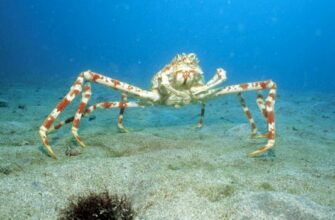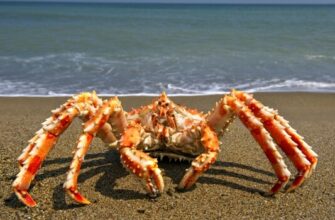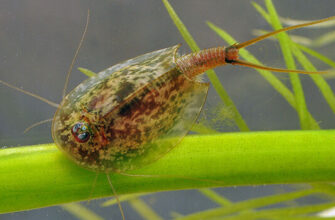The amphipod is a crustacean animal belonging to the order of higher crayfish (Amphipoda). In total, about 9,000 species of crustaceans are known that live at the bottom of the seas and other bodies of water around the world. Most of the crustaceans belonging to this order live in the coastal zone near the surf, they can get ashore. Parasitic forms are also represented in this order. They include whale lice.
Origin of the species and description
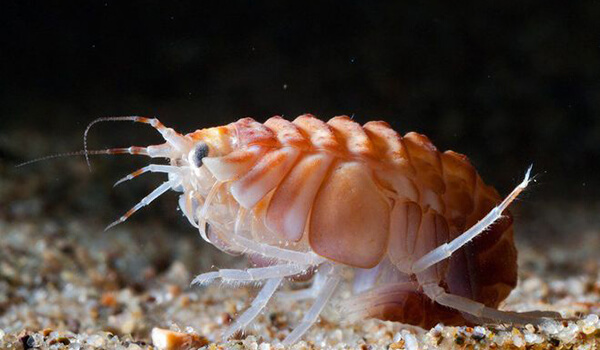
Photo: Amphipod
Amphipods (Amphipoda) are arthropods belonging to the class of higher crayfish, the amphipod order. This detachment was first described by the French entomologist Pierre André Latreille in 1817. This order includes more than 9000 species of crustaceans. Amphipods are very ancient creatures, it is known that these crustaceans inhabited the benthos of the seas and fresh water bodies at the beginning of the Stone period of the Paleozoic era, which is about 350 million years ago.
Video: Amphipod
However, due to the absence of carapace, the remains of these animals have almost not been preserved, only 12 specimens of ancient crustaceans of this order are known. Fossils of ancient amphipods that lived during the Eocene period have been preserved. These fossils have survived to this day thanks to amber. An ancient animal fell into a drop of amber and could not get out of it, and only thanks to this circumstance can we know that these creatures lived during the Paleozoic era.
In 2013, an amphipod was described that lived in the Triassic period of the Mesozoic era, which is almost 200 million years older than the previous specimen.
This amphipod species Rosagammarus minichiellus in the same year, this fossil was described by a group of scientists under the representation of Mark McMenamin. At the moment, the population of crustaceans is extremely diverse. This order also includes some planktonic organisms.
Appearance and description
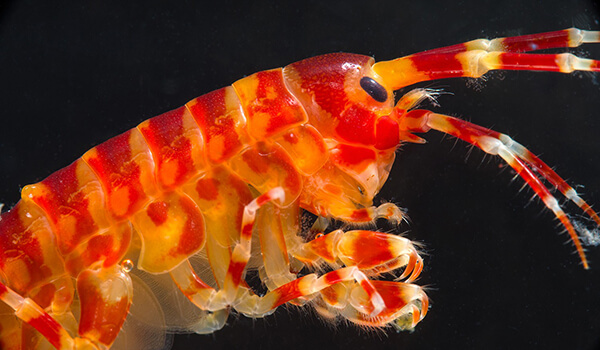
Photo: What the amphipod looks like
Amphipods are very small crustaceans. The size of an average individual is only about 10 mm in length, however, there are also large individuals about 25 mm in size, but rarely. Representatives of small species of amphipods are very tiny and their size is only 1 mm in length.
The body of amphipods is flattened laterally. The main difference between amphipods and other crustaceans is the absence of carapace. On the thorax, the anterior segment is completely fused with the head. The limbs on the first segment are represented by mandibles. The limbs on the chest have a different structure. On the front pair of limbs there are large false claws. These pincers are essential for grasping food. The next two pairs end with claws. Only on the front claws are directed forward, and the rear claws are directed back.
Thanks to these claws, the animal can easily move along the subrostat. Gills are located between the 2nd and 7th thoracic segments. Amphipod belly divided into several sections — urosoma and pleosoma. Each of the sections includes 3 segments. On the segments of the pleosome there are pleopods biramous limbs used for swimming.
On the uresome there are uropod limbs thanks to which the crustacean can jump high and move quickly along the shore and along the bottom of the reservoir. Urepods are quite strong. The excretory system is represented by the intestine and the anus.
Where does the amphipod live?
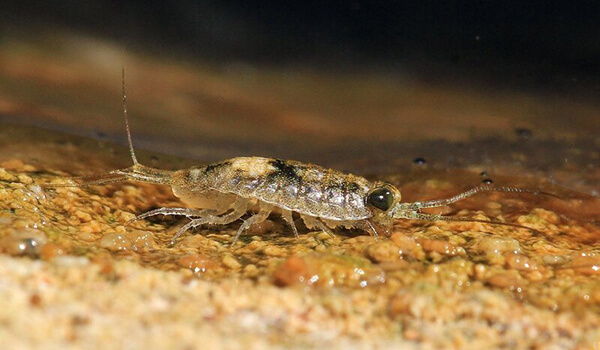
Photo: Amphipod in the river
The Amphipod is extremely common creatures. They live in almost all freshwater bodies of water, seas, at the bottom of the oceans. In addition, many amphipods live in groundwater. They can be found in the springs and wells of the Caucasus, Ukraine in Western Europe.
The suborder Ingol-fiellidea lives in the underground waters of Africa, southern Europe and America. And also several species of these crustaceans live in the capillary passages of sand on the shores of Peru, the English Channel and in the Gulf of Thailand. Species Gammarus pulex, G. kischinefensis, G. balcanicus. They inhabit the reservoirs of England, Moldova, Germany and Romania. In our country, these crustaceans live in almost all water bodies.
Marine amphipods live in the Azov, Black and Caspian Seas. Amphipods of several species live in the Volga, Oka and Kama rivers: Niphargoides sarsi, Dikerogammarus haemobaphes, Niphargoides sarsi. There are more than 20 species of these crustaceans in the Yenisei and the Angarsk reservoir. Well, the most diverse fauna in Lake Baikal. At the bottom of Lake Baikal there are 240 species of crustaceans. All crustaceans live at the bottom of water bodies and lead a planktonic lifestyle.
An interesting fact: At the bottom of the Oka River, only in its lower course, there are about 170 thousand individuals of amphipods of the genus Corophium per square meter of bottom .
Now you know where the amphipod is found. Let's see what it eats.
What do amphipods eat?
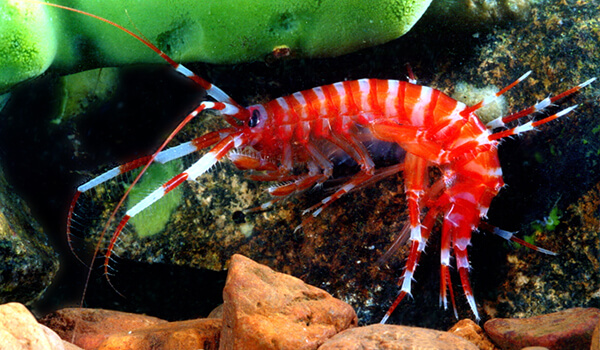
Photo: Amphipod
Almost all amphipods are omnivores.
The main diet of amphipods includes:
- underwater plants (both living and dead parts);
- remains of fish and other animals;
- soil;
- algae;
- small animals.
The way you eat can be different. These crustaceans bite off large food with their chews and break it into small pieces. Powerful jaws retain pieces of food preventing it from falling out of the mouth. Some species of amphipods feed by filtering the suspension that the waves bring. These crustaceans usually live in the coastal strip. When they feel that the wave is moving away from the shore, the crayfish hide in the ground only slightly sticking out of it, when the ground is exposed, the crustaceans plunge into it entirely, as Niphargoides maeoticus usually feeds.
Crustaceans of the species Corophiidae, Leptocheirus and Ampeliscidae feed without leaving their houses. There, these animals begin to stir up the top layer of soil with their rear antennas. Algae and bacteria get into the water, and the cancer filters the water by passing it through a network of bristles that is located on the front legs. Predators among amphipods are sea goats.
These small crustaceans attack smaller relatives, worms, jellyfish. Planktonic amphipods of the species Lysianassidae live on jellyfish and lead a semi-parasitic lifestyle. A parasitic species of amphipods Cyamidae whale lice. These small parasites settle on whales near the anus and feed on the skin of whales, gnawing deep ulcers.
Character and Lifestyle Features
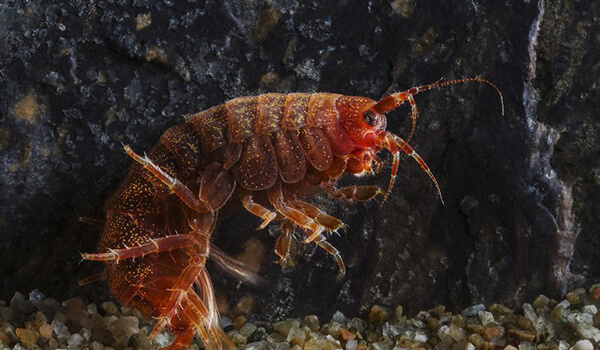
Photo: Amphipod
Most amphipods lead a semi-submerged lifestyle. During the day, they live at the bottom of the reservoir, while at night, these small crustaceans get out onto land and can crawl along the beach in search of food. They usually eat rotting seaweed that is washed ashore by the waves. In the daytime, the crustaceans return to the reservoir or hide in the soil, protecting the gills from drying out.
Like many crayfish, amphipods breathe with gills, the gill plates are pierced by thin vessels that retain moisture and this allows the crustaceans to get out onto land. The crustaceans have an amazing ability to navigate in space, even moving far away from the water, they can accurately determine where they need to return.
Some amphipods seek out snags and branches by feeding on tree sawdust and dust. Predatory amphipod sea goats almost all the time hide among the thickets of grass. They track down the prey for a long time sitting in one place, slightly raising the front claws, as soon as it sees the prey sharply and attacks it.
Whale lice lead a parasitic lifestyle, and spend almost their entire lives on whales feeding on their skin. Small crustaceans living on the seabed lead a calm lifestyle. Some hardly come out of their burrows, feeding on the filtering method by constantly digging the bottom.
Social Structure and Reproduction
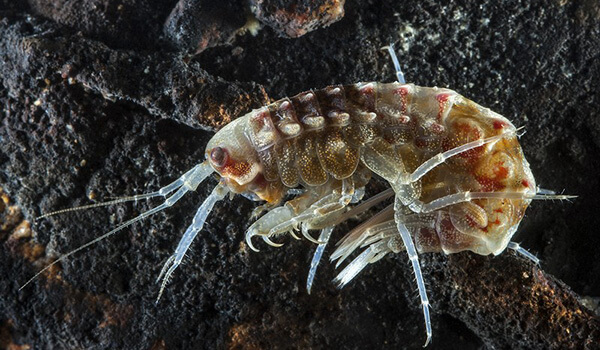
Photo: Amphipod Crawfish
Amphipods are diverse creatures. Sexual dimorphism is often pronounced. Depending on the species, males may be larger than females, or vice versa. In the Gammaridae family, males are many times larger than females. In the Leptocheirus family, on the contrary, females are larger than males. Sexually mature females of all amphipod species have a brood pouch.
An interesting fact: The development of male sexual characteristics in amphipods is due to the presence of a special hormone that is secreted by androgenic endocrine glands. The transplantation of these glands from a female resulted in the degeneration of the female's ovaries into testes.
In the amphipod Gammarus duebeni, the sex of the offspring is determined by the temperature at which the eggs mature. In the cold season, males are hatched; in the warm season, females are born. The mating process in amphipods lasts several days. The male clings to the back of the female, holding on to the anterior and posterior edges of the fifth thoracic segment of the female with his strong claws, waiting for the molt.
After molting, the male moves to the female's abdomen and folds the abdominal legs together, inserting them several times between the rear plates of the brood pouch. At this time, semen is secreted from the genital openings. With the help of the abdominal legs, the sperm is transferred inside the brood pouch. After 4 hours, the female lays eggs in this bag and they are immediately fertilized. In different species of amphipods, the number of eggs that the female lays is different. In general, females lay from 5 to 100 eggs per mating.
But some species are more prolific, for example, Gammara-canthus loricatus lays up to 336 eggs, Amathillina spinosa up to 240. The most prolific are the White Sea amphipods Apopukh nugax, after one mating, the female bears up to a thousand embryos. Amphipod embryos in the egg are curved towards the abdomen. From the moment of fertilization, it takes 14 to 30 days before the little crustaceans leave the mother's brood pouch.
Small crustaceans grow very quickly, going through about 13 molts. Most species of amphipods breed in the warm season, but amphipods of the genus Anisogammarus hatch eggs all winter, and by spring small crustaceans are born. The average life expectancy of amphipods is about 2 years. Representatives of the species Niphargus orcinus virei live the longest, they can live up to 30 years, but on average they live about 6 years.
Natural enemies of amphipods
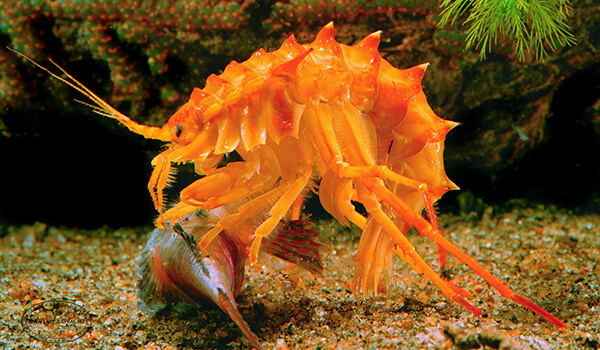
Photo: What the amphipod looks like
The main enemies of amphipods are:
- fish;
- whales and killer whales;
- turtles;
- minks;
- cats;
- dogs;
- muskrats;
- frogs and other amphibians;
- insects and their larvae;
- arachnids;
- birds (mainly sandpipers).
Amphipods are very small and almost defenseless creatures. Therefore, in the natural environment, these crustaceans have plenty of enemies. Because of this, crustaceans try to lead a more or less secretive lifestyle. In the rivers amphipods are hunted by eels, burbot, perches, roach, bream and many other fish. Eels are considered the most dangerous enemies of these crustaceans, as these fish constantly dig the ground and easily climb into the holes of crayfish.
Birds and predatory mammals lie in wait on the shore of crayfish. But most amphipods die not from falling into the clutches of predators, but from diseases. And the most dangerous of them is the crayfish plague. It is the plague that destroys thousands of crustaceans every year. Crustaceans and parasitic diseases suffer, even these small creatures are inhabited by parasites. The most vulnerable are crustaceans that have received any injuries; various bacteria multiply rapidly on the wounds.
Water pollution is also an unfavorable factor. Amphipods are very sensitive to the ingress of harmful substances into the water, cases of mass death of these crustaceans in places of severe pollution of water bodies are known.
Population and species status
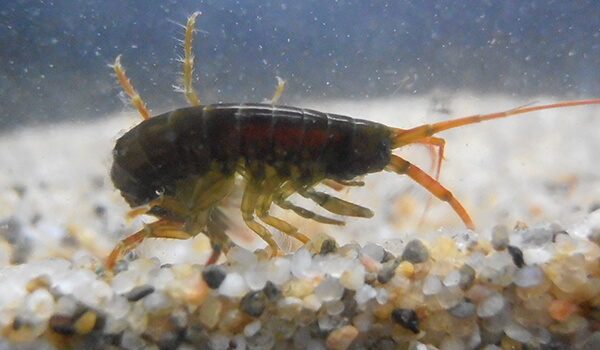
Photo: Amphipod
Amphipods are the most numerous class of crustaceans. This class does not need special protection. It is impossible to track the number of populations due to the very large number of crustaceans of various species that live in all reservoirs. These small crustaceans feel comfortable in the wild, adapt well to various environmental conditions and multiply quickly.
Fishing for amphipods is permitted. Small crustaceans in our country are caught in an environmentally friendly way. Krill meat is a delicious and nutritious food rich in vitamins and minerals. Many species of amphipods are used in fishing as bait. Fishermen use the mormyshka to fish for perch, bream, crucian carp and other types of fish.
Amphipods are real orderlies of reservoirs. These small crustaceans eat the remains of animal corpses, decaying plants, and plankton. That is, everything in which dangerous and pathogenic bacteria can successfully multiply. Feeding these crustaceans purify the water, making it clean and transparent. Predatory species of crustaceans regulate the population of jellyfish and other creatures that are hunted.
All that can be done for amphipods is to keep water bodies clean, install treatment facilities at enterprises and ensure that dangerous and toxic substances do not get into the water .
Interesting fact: Amphipods are also called sea fleas, but unlike land fleas, these creatures do not harm humans and land mammals.
The amphipod is an amazing creature that inhabits bodies of water all over the world in huge numbers. Thousands of these small crustaceans live in any reservoir. Despite their small size, these are very nimble creatures leading an active lifestyle. They are able to swim well, and move quite quickly along sandy beaches with the help of jumps. Sometimes these little creatures are compared to vultures, because of their habit of eating carrion. Crustaceans have a very important role in the ecosystem, as they are the orderlies of water bodies and are food for a large number of underwater animals, mammals and birds.

